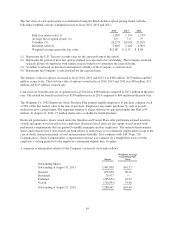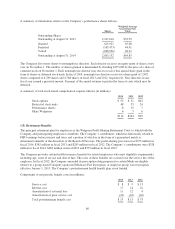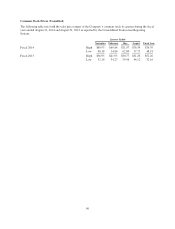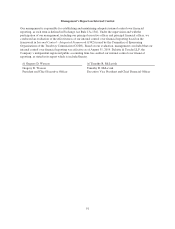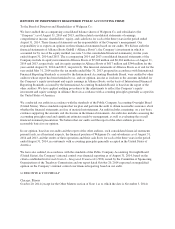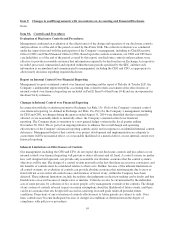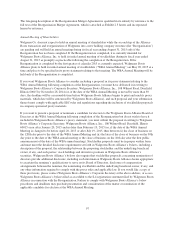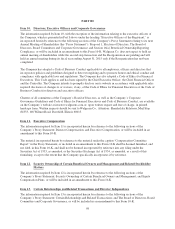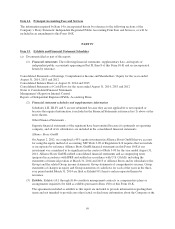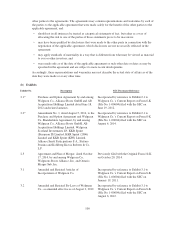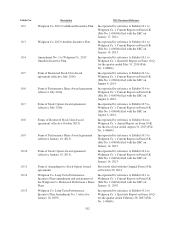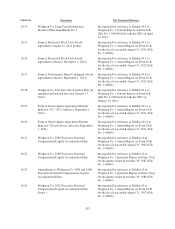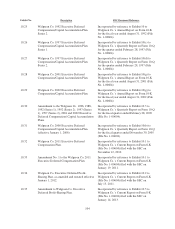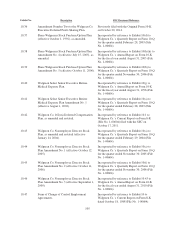Walgreens 2014 Annual Report Download - page 103
Download and view the complete annual report
Please find page 103 of the 2014 Walgreens annual report below. You can navigate through the pages in the report by either clicking on the pages listed below, or by using the keyword search tool below to find specific information within the annual report.
Item 9. Changes in and Disagreements with Accountants on Accounting and Financial Disclosure
None.
Item 9A. Controls and Procedures
Evaluation of Disclosure Controls and Procedures
Management conducted an evaluation of the effectiveness of the design and operation of our disclosure controls
and procedures as of the end of the period covered by this Form 10-K. The controls evaluation was conducted
under the supervision and with the participation of the Company’s management, including its Chief Executive
Officer (CEO) and Chief Financial Officer (CFO). Based upon the controls evaluation, our CEO and CFO have
concluded that, as of the end of the period covered by this report, our disclosure controls and procedures were
effective to provide reasonable assurance that information required to be disclosed in our Exchange Act reports is
recorded, processed, summarized and reported within the time periods specified by the SEC, and that such
information is accumulated and communicated to management, including the CEO and CFO, as appropriate to
allow timely decisions regarding required disclosure.
Report on Internal Control Over Financial Reporting
Management’s report on internal control over financial reporting and the report of Deloitte & Touche LLP, the
Company’s independent registered public accounting firm, related to their assessment of the effectiveness of
internal control over financial reporting are included in Part II, Item 8 of this Form 10-K and are incorporated in
this Item 9A by reference.
Changes in Internal Control over Financial Reporting
In connection with the evaluation pursuant to Exchange Act Rule 13a-15(d) of the Company’s internal control
over financial reporting (as defined in Exchange Act Rule 13a-15(f)) by the Company’s management, including
its CEO and CFO, no changes during the quarter ended August 31, 2014 were identified that have materially
affected, or are reasonably likely to materially affect, the Company’s internal control over financial
reporting. The Company plans to transition to a new general ledger system in the fiscal quarter ending
November 30, 2014. This is part of an ongoing initiative to enhance the overall design and operating
effectiveness of the Company’s financial reporting controls and is not in response to an identified internal control
deficiency. Management believes that controls over project development and implementation are adequate to
assure there will be no material effect, or a reasonable likelihood of a material effect, on our internal control over
financial reporting.
Inherent Limitations on Effectiveness of Controls
Our management, including the CEO and CFO, do not expect that our disclosure controls and procedures or our
internal control over financial reporting will prevent or detect all errors and all fraud. A control system, no matter
how well designed and operated, can provide only reasonable, not absolute, assurance that the control system’s
objectives will be met. The design of a control system must reflect the fact that there are resource constraints, and
the benefits of controls must be considered relative to their costs. Further, because of the inherent limitations in
all control systems, no evaluation of controls can provide absolute assurance that misstatements due to error or
fraud will not occur or that all control issues and instances of fraud, if any, within the Company have been
detected. These inherent limitations include the realities that judgments in decision-making can be faulty and that
breakdowns can occur because of simple error or mistake. Controls can also be circumvented by the individual
acts of some persons, by collusion of two or more people, or by management override of the controls. The design
of any system of controls is based in part on certain assumptions about the likelihood of future events, and there
can be no assurance that any design will succeed in achieving its stated goals under all potential future
conditions. Projections of any evaluation of controls effectiveness to future periods are subject to risks. Over
time, controls may become inadequate because of changes in conditions or deterioration in the degree of
compliance with policies or procedures.
95


